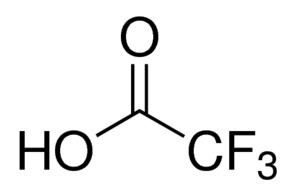Appearance colorless liquid Molar mass 114.02 g/mol Main hazards Highly corrosive Acidity (pKa) 0.23 | Density 1.49 g/cm³ Boiling point 72.4 °C R-phrases R20 R35 R52/53 S-phrases S9 S26 S27 S28 S45 S61 | |
 | ||
Related perfluorinated acids Related compounds | ||
Trifluoroacetic acid
Trifluoroacetic acid (TFA) is an organofluorine compound with the chemical formula CF3CO2H. It is a colorless liquid with a sharp odor similar to vinegar, but stronger in acidity. TFA is an analogue of acetic acid with the three hydrogen atoms replaced by three fluorine atoms. The acidity of TFA is approximately 34,000 times stronger than that of acetic acid due to the electronegativity of the trifluoromethyl group. TFA is widely used in organic chemistry for various purposes.
Contents
Synthesis
TFA is prepared industrially by the electrofluorination of acetyl chloride and acetic anhydride, followed by hydrolysis of the resulting trifluoroacetyl fluoride:
CH3COCl + 4 HF → CF
3COF + 3 H
2 + HCl CF
3COF + H
2O → CF
3COOH + HF
Where desired, this compound may be dried by addition of trifluoroacetic anhydride.
An older route to TFA proceeds via the oxidation of 1,1,1-trifluoro-2,3,3-trichloropropene with potassium permanganate. The trifluorotrichloropropene can be prepared by Swarts fluorination of hexachloropropene.
TFA occurs naturally in sea water, but only in small concentrations (<200 ng/L).
Uses
TFA is the precursor to many other fluorinated compounds such as trifluoroacetic anhydride, trifluoroperacetic acid, and 2,2,2-trifluoroethanol. It is a reagent used in organic synthesis because of a combination of convenient properties: volatility, solubility in organic solvents, and its strength as an acid. TFA is also less oxidizing than sulfuric acid but more readily available in anhydrous form than many other acids. One complication to its use is that TFA forms an azeotrope with water (b. p. 105 °C).
TFA is popularly used as a strong acid in peptide synthesis and other organic synthesis to remove the t-butoxycarbonyl protecting group.
At a low concentration, TFA is used as an ion pairing agent in liquid chromatography (HPLC) of organic compounds, particularly peptides and small proteins. TFA is a versatile solvent for NMR spectroscopy (for materials stable in acid). It is also used as a calibrant in mass spectrometry.
TFA is used to produce trifluoroacetate salts.
Safety
Trifluoroacetic acid is a corrosive acid but it does not pose the hazards associated with hydrofluoric acid because the carbon-fluorine bond is not labile. Only if heated or treated with ultrasonic waves will it decompose into hydrofluoric acid. TFA is harmful when inhaled, causes severe skin burns and is toxic for water organisms even at low concentrations.
TFA's reaction with bases and metals, especially light metals, is strongly exothermic. The reaction with lithium aluminium hydride (LAH) results in an explosion.
Environment
TFA is neither readily nor inherently biodegradable although it does not readily bioaccumulate. In water, it is toxic to algae.
